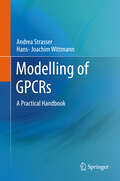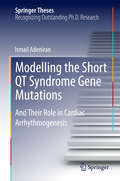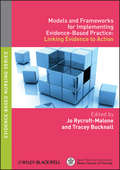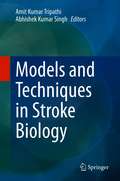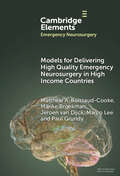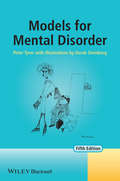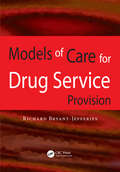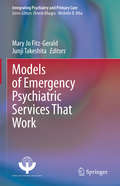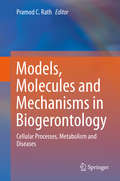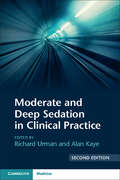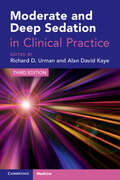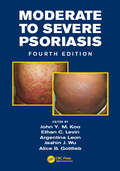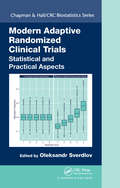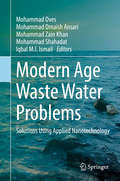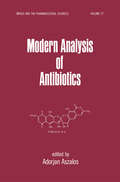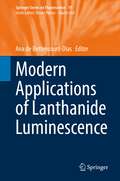- Table View
- List View
Modelling of GPCRs
by Andrea Strasser Hans-Joachim WittmannG protein coupled receptors (GPCRs) comprise an important protein family, which is involved in signal transduction in the cell. Besides that a large number of drugs, available on market, address GPCRs. For an efficient and improved development of appropriate drugs, molecular modelling of GPCRs is - in order to understand the ligand-receptor interactions and functionality of GPCRs on molecular level - an important tool. The book "Modelling of GPCRs - a practical handbook" is focussed onto a practical introduction into molecular modelling of GPCRs. This book is very useful for beginners in GPCR modelling, but also addresses the advanced GPCR modeller: On the one hand, the book introduces principles of GPCR modelling, including extensive examples. On the other hand, detailed outlooks onto advanced GPCR modelling techniques are presented. Furthermore, the book includes important data, like information about crystal structures in a summarized manner or amino acid sequences, which are essential for GPCR modelling in general. Due to an increase in efficacy and data handling most modellers use LINUX as operating system. To address this, a summary of most important LINUX commands with examples is presented within the book.
Modelling the Short QT Syndrome Gene Mutations
by Ismail AdeniranThe Short QT Syndrome (SQTS) is characterized by abbreviated QT intervals on the electrocardiogram, increased risk of cardiac arrhythmias and sudden death. Although several gene mutations have been identified in SQT patients, the role of these mutations in promoting arrhythmogenesis is still not completely understood. Consequently, this thesis employs multidisciplinary approaches to develop a 3D virtual heart, which is then used to elucidate how the short QT syndrome facilitates and maintains ventricular arrhythmias and to determine its effects on ventricular mechanical contraction. The findings in this thesis provide a comprehensive and mechanistic explanation for a number of gene mutations associated with potassium channels in terms of susceptibility to arrhythmia. The multiphysics models developed provide a powerful platform for identifying the root causes of various arrhythmias and investigating therapeutic interventions for these diseases. The thesis was examined by Prof. Chris Huang of the University of Cambridge, the most authoritative figure in cardiac electrophysiology, who has described the work as "outstanding. "
Modelling the Toxicity of Nanoparticles (Advances in Experimental Medicine and Biology #947)
by Lang Tran, Miguel A. Bañares and Robert RalloIn today’s nanotechnology and pharmaceutical research, alternative toxicology testing methods are crucial for ethically and commercially sound practice. This book provides practical guidelines on how to develop and validate quantitative nanostructure-toxicity relationship (QNTR) models, which are ideal for rapidly exploring the effects of a large number of variables in complex scenarios. Through contributions by academic, industrial, and governmental experts, Modelling the Toxicity of Nanoparticles delivers clear instruction on these methods and their integration and use in risk assessment. Specific topics include the physico-chemical characteristics of engineered nanoparticles, nanoparticle interactions, in vivo nanoparticle processing, and more. A much-needed practical guide, Modelling the Toxicity of Nanoparticles is a key text for researchers as well as government and industry regulators.
Models and Frameworks for Implementing Evidence-Based Practice
by Jo Rycroft-Malone Tracey BucknallThe Evidence-Based Nursing Series is co-published with Sigma Theta Tau International (STTI). The series focuses on implementing evidence-based practice in nursing and mirrors the remit of Worldviews on Evidence-Based Nursing, encompassing clinical practice, administration, research and public policy. Models and Frameworks for Implementing Evidence- Based Practice: Linking Evidence to Action looks at ways of implementing evidence gained through research and factors that influence successful implementation. It acknowledges the gap that exists between obtaining evidence and the practicalities of putting it into practice and provides direction to help to close this gap. This, the first book in the series, helps the reader to make decisions about the appropriateness of using various models and frameworks. A selection of models and frameworks are examined in detail including examples of their use in practice. The book concludes with an analysis and synthesis of the included models and frameworks. The models and frameworks that have been included are based on a number of criteria: that they are internationally recognised, have undergone widespread evaluation and testing, are transferable across different settings, and can be used by different disciplines. Models and frameworks include:Stetler ModelOttowa Model of Research UseIOWA model of evidence-based practiceAdvancing Research and Clinical Practice through Close Collaboration (ARCC) modelDobbins' dissemination and use of research evidence for policy and practice frameworkJoanna Briggs Institute modelKnowledge to Action frameworkPromoting Action on Research Implementation in Health Services (PARIHS)Key Points:Includes an overview of implementation issues and the use of theory and frameworks in implementing evidence into practiceChapters are written by the developers of the model or frameworkEach chapter provides background on an implementation model or framework, suitable applications, underlying theory and examples of useEach chapter examines strengths and weaknesses of each model alongside barriers and facilitators for its implementation
Models and Techniques in Stroke Biology
by Amit Kumar Tripathi Abhishek Kumar SinghThis book summarizes various tools and techniques used to provide insights into the cellular and molecular pathophysiology of stroke. It also presents rodent animal models to help shed light on the pathophysiology of ischemic stroke. Presenting the latest information on the different types of stroke, including embolic, filament, photothrombotic, and bilateral common carotid artery, the book also describes techniques that are used for confirmation of stroke surgery, such as laser speckle imaging (LSI) and laser Doppler flowmetry (LDF), and discusses the non-human primates that are used in stroke surgery, cerebral venous sinuous thrombosis, and neurobehavioral assessment. Lastly, it analyzes various neuroprotective agents to treat and prevent ischemic stroke, and examines the challenges and advances in treating and preventing acute ischemic stroke.
Models for Delivering High Quality Emergency Neurosurgery in High Income Countries (Elements in Emergency Neurosurgery)
by Paul Grundy Marco Lee Marike Broekman Matthew A. Boissaud-Cooke Jeroen van DijckEmergency neurosurgery encompasses serious and high-risk cranial and spinal conditions across all ages. The authors provide an overview of the changes occurring within emergency surgery to meet the challenges provided from unscheduled care. Considering the wider landscape of emergency surgery provides a context for the changes occurring within emergency neurosurgery. The delivery of emergency neurosurgery within the UK, the Republic of Ireland, the Netherlands, and the United States of America (USA) is then described to provide an overview of different models of care.
Models for Mental Disorder
by Peter TyrerModels for Mental Disorder, first published in 1987, anticipated the move towards integration of psychiatric services into multidisciplinary teams (doctor, psychologist, nurse, social worker, etc) and the need to bring together the different philosophies of mental illness. Peter Tyrer has identified four different models of mental disorder that are relevant to clinical practice: the disease, psychodynamic, cognitive-behavioural and social models. Each model is described and reviewed, with reference to case studies and illustrations, to show how it relates to mental health disorders and can be used to interpret and manage these disorders.The book has been widely read and is often used for training purposes so that each professional can understand and appreciate that differences in viewpoint are often a consequence of one or more models being used in a different way rather than a fundamental schism in approach.Since the fourth edition was published in 2005, the disciplines of mental health have moved even closer together with the growth of assertive outreach and more integrated community teams. This, combined with the greater awareness of mental health among users of services, which leads to more penetrating and informed questions at interviews with professionals, has emphasised the need for a wider understanding of these models.Table of contents:Chapter 1 IntroductionChapter 2 The Disease ModelChapter 3 The Psychodynamic ModelChapter 4 The Cognitive-Behavioural ModelChapter 5 The Social ModelChapter 6 Working Models in PracticeAppendix 1 Teaching Exercise: Teaching the ModelsGlossary of Terms
Models of Care for Drug Service Provision
by Richard Bryant-JefferiesModels of Care for Drug Service Provision encourages a greater understanding of the Models of Care system, and how it can be used in the interest of clients’ health and well-being. It describes the different range of treatment responses that can be offered and illustrates the patient’s journey through this model. It uses a fictitious account of a client with a drug problem to highlight the various technical aspects of treatments and issues that can commonly arise. "This new book is a wonderful reminder that we are dealing first and foremost with human beings who are complex, vulnerable and who also happen to have a drug problem. Our treatment professionals need to be well informed, up to date and responsive to the needs of clients. They also need to be understanding, tolerant and resourceful. Models of Care for Drug Service Provision assists them by providing a framework within which to work and by helping to bind together the range of professionals and services into a system of care."— Don Lavoie, National Treatment Agency
Models of Care in Women's Health
by Tahir Mahmood Allan Templeton Charnjit DhillonThis book helps to improve the quality of the care in gynaecological practice. Improvement is driven by clinical effectiveness and increasing patient demands, and for each area of practice described this book outlines the service organization needed to achieve this improvement. The goal is to help clinicians take responsibility for developing services that meet the needs of their patients as well as managing their individual medical conditions. The book demonstrates that much can be achieved within current resources and without the need for major additional expense. Different approaches are demonstrated but the key issue is the patient pathway, with the underlying philosophy of continuous improvement in quality. Trainees, clinicians, managers and commissioners of services in obstetrics and gynaecology will find this book of immense practical value.
Models of Emergency Psychiatric Services That Work (Integrating Psychiatry and Primary Care)
by Mary Jo Fitz-Gerald Junji TakeshitaThis book describes a spectrum of possible solutions to providing comprehensive emergency psychiatric care. It discusses in detail all components of emergency psychiatric care, such as triage, security, management of suicide risk, violent patients, interdisciplinary treatment teams, administration, and telepsychiatry. It has been written by and is of interest to psychiatrists, emergency medicine physicians, nurses, social workers, administrators, the police and security staff.
Models of Lung Disease: Microscopy and Structural Methods (Lung Biology In Health And Disease Ser. #47)
by Joan GilThis research-level reference provides a review of the morphological techniques that have become a primary method of anatomical study correlating structure and function in lung physiology and pathology. Detailing the evolution of anatomy as a research discipline, it explores general structural techn
Models of Wave Memory
by Serguey KashchenkoThis monograph examines in detail models of neural systems described by delay-differential equations. Each element of the medium (neuron) is an oscillator that generates, in standalone mode, short impulses also known as spikes. The book discusses models of synaptic interaction between neurons, which lead to complex oscillatory modes in the system. In addition, it presents a solution to the problem of choosing the parameters of interaction in order to obtain attractors with predetermined structure. These attractors are represented as images encoded in the form of autowaves (wave memory). The target audience primarily comprises researchers and experts in the field, but it will also be beneficial for graduate students.
Models, Molecules and Mechanisms in Biogerontology: Cellular Processes, Metabolism and Diseases
by Pramod C. RathThe book deals with basic cellular and molecular mechanisms associated with aging. It comprehensively describes the important genetic, epigenetic, biochemical and metabolic regulations during aging, as well as some important age-related diseases.The book is divided into four major sections for easy understanding. It takes the readers through the various aspects of aging in a story-like manner. Certain interventions for healthy aging such as dietary restriction, regular exercise and maintaining a balanced and peaceful life-style are also suggested by the experts. The book would be a companion for both beginners, as well as established researchers in the field. It would be useful for science education, research, clinical approach and policy making.
Models, Molecules and Mechanisms in Biogerontology: Physiological Abnormalities, Diseases and Interventions
by Pramod C. RathThis book examines the basic cellular and molecular mechanisms associated with aging. It comprehensively describes the genetic, epigenetic, biochemical and metabolic regulation of aging, as well as some important age-related diseases. Divided into two major sections, it takes readers through the various aspects of aging in a story-like manner and suggests various interventions for healthy aging, such as dietary restriction, regular exercise, nutrition and maintaining a balanced and a non-stressful lifestyle. It describes the implications of aging on the nervous system, metabolism, immunity and stem cells as well as care for the elderly. The book is an ideal companion for both new and established researchers in the field and is also useful for educators, clinicians and policy makers.
Moderate Sedation and Emergency Medicine for Periodontists
by Joseph A. Giovannitti Jr.This book is intended for periodontal residents and practicing periodontists who wish to incorporate the principles of moderate sedation into daily practice. A history of the development of sedation in dental practice sets the stage for understanding the need for a comprehensive preanesthetic evaluation to identify potentially reactive patients prior to treatment. Useful drugs for moderate sedation and reversal agents in the office setting are reviewed to ensure proper perioperative usage. Comprehensive airway management and rescue skills are then documented in detail so that the patient may be properly managed in the event that the sedation progresses beyond the intended level. A key aim is to equip the reader with sufficient knowledge and preparedness to overcome the patient management challenges associated with common and uncommon deviations from intraoperative norms. Finally, for those academicians interested in teaching the principles of sedation to periodontal residents, a curriculum development tool is provided to ensure comprehensive training leading to competency.
Moderate and Deep Sedation in Clinical Practice
by Kaye Urman Richard D. Alan D.Millions of procedures requiring sedation are performed each year, covering a large array of medical specialties in both inpatient and outpatient settings. This tremendous growth has led to sedation being administered by a wide range of healthcare providers, including non-anesthesiologist physicians, nurses and nurse practitioners. Moderate and Deep Sedation in Clinical Practice is a concise, practical handbook for all medical and surgical professionals who sedate patients. This up-to-date, evidence-based 'how-to' manual instructs these professionals on how to evaluate patients, updates relevant pharmacology, and guides them on legal and quality assurance issues. It contains advice on sedation for specific populations, such as elderly, pediatric, ICU, emergency room, endoscopy, and reproductive technologies. Written and edited by experts in procedural sedation and sedation education, this book will help users develop safer techniques, policies, and procedures. It is essential reading for any healthcare provider administering moderate or deep sedation.
Moderate and Deep Sedation in Clinical Practice
by Alan D. Kaye Richard D. UrmanMillions of procedures requiring sedation are performed each year; many occur outside of the operating room in both inpatient and outpatient settings. This tremendous growth has resulted in sedation being administered by a wide range of healthcare providers, including non-anesthesiologist physicians, nurses and nurse practitioners. Moderate and Deep Sedation in Clinical Practice is a concise, practical handbook for all medical and surgical professionals who sedate patients. This up-to-date, evidence based, 'how to' manual will: * Tell you how to evaluate patients * Update you on relevant pharmacology * Advise you on sedation for specific populations: elderly, pediatric, ICU, emergency room, endoscopy and reproductive technologies * Guide you on legal and quality assurance issues Written and edited by experts in procedural sedation and sedation education, this book will help users develop safer techniques, policies and procedures. Essential reading for any healthcare provider administering moderate or deep sedation.
Moderate and Deep Sedation in Clinical Practice
by Richard D. Urman Alan David KayeWith the number of surgical procedures requiring sedation increasing every year, most hospitals and other facilities now have a procedural (moderate/deep) sedation program. The third edition of this popular handbook provides concise, practical, and evidence-based guidance on safe and effective procedural sedation. Featuring contributions from national experts, chapters cover the description/definition of sedation levels, patient evaluation, pharmacology, legal and quality assurance issues, as well as sedation for specific populations (ambulatory/office settings, elderly, pediatric, ICU, emergency room, endoscopy, reproductive technologies). The book also reviews the specific clinical and administrative considerations for the nursing and PA staff often involved in administering sedation. Comprehensively updated to incorporate the most current, evidence-based information including updates to existing guidelines, patient outcomes data from the most recently published papers and expanded sedation-related content in sub-specialties. An essential manual for a wide array of healthcare providers to develop safer techniques, policies, and procedures for moderate and sedation.
Moderate to Severe Psoriasis
by John Koo Argentina Leon Ethan Levin Jashin Wu Alice GottliebWritten by experts in the dermatology field, this new fourth edition of Moderate-to-Severe Psoriasis discusses the current use of biologics and other pharmacologic and phototherapy treatments for moderate-to-severe psoriasis. Illustrated with high quality color figures, this standalone text emphasizes safe and effective treatments for the psoriasis patient that are perfect for the dermatologist in daily practice. New to this edition are chapters on day treatment programs, new agents, erythrodermic and pustular psoriasis, special populations, and pharmacogenetics.
Modern Adaptive Randomized Clinical Trials: Statistical and Practical Aspects (Chapman & Hall/CRC Biostatistics Series)
by Oleksandr SverdlovIs adaptive randomization always better than traditional fixed-schedule randomization? Which procedures should be used and under which circumstances? What special considerations are required for adaptive randomized trials? What kind of statistical inference should be used to achieve valid and unbiased treatment comparisons following adaptive random
Modern Age Waste Water Problems: Solutions Using Applied Nanotechnology
by Mohammad Oves Mohammad Zain Khan Iqbal M.I. Ismail Mohammad Omaish Ansari Mohammad ShahadatThis book presents a picture of the advances in the research of theoretical and practical frameworks of wastewater problems and solutions. The book deals with a basic concept and principles of modern biological, chemical and technical approaches to remediate various hazardous pollutants from wastewater. The latest empirical research findings in wastewater treatment are comprehensively discussed. Examples of low-cost technologies are also included.The book is written for professionals, researchers, academics and students wanting to improve their understanding of the strategic role of environmental protection and advanced applied technologies.
Modern Analysis of Antibodies
by Adorjan AszalosThis book brings together an up-to-date account of instructions in the chemical and biological methods of analysis for antibiotics. It is helpful for all scientific workers in the diversified community of industrial, medical, academic, and governmental antibiotic laboratories.
Modern Applications of Lanthanide Luminescence (Springer Series on Fluorescence #19)
by Ana de Bettencourt-DiasThis volume builds upon the successful book Lanthanide Luminescence published in the Springer Series on Fluorescence in 2011. Since its publication, the field of lanthanide spectroscopy and the areas in which the light emission properties of the f-elements are used have experienced substantial advances. The luminescence properties of lanthanide ions make them unique candidates for a myriad of optical applications. This book highlights and reviews the latest research in areas ranging from luminescence thermometry to imaging, sensing and photonic applications of these fascinating elements. Each chapter provides a comprehensive introduction to a specific area of application of lanthanide luminescence and extensively reviews seminal papers and current research literature. Given its interdisciplinary scope, the book appeals to scientists and advanced students in physics, chemistry and materials science interested in compounds and materials with optical properties.
Modern Approaches to Augmentation of Brain Function (Contemporary Clinical Neuroscience)
by Manuel F. Casanova Ioan Opris Mikhail A. LebedevThis book covers recent advances in neural technology that provide for enhancements for brain function. It addresses a broad range of neural phenomena occurring in the brain circuits involved in perception, cognition, emotion and action, that represent the building blocks of behavior and cognition. Augmentation of brain function can be achieved by using brain implants for recordings, stimulation, or drug delivery. Alternative methods include employing brain-machine interfaces, as well as noninvasive activation of certain brain areas. This volume evaluates existing methods of brain augmentation while discussing the brain circuitry and neuronal mechanisms that make augmentation possible. This volume offers novel insights into brain disorders, and explores new devices for brain repair while also addressing the philosophical and ethical implications of brain augmentation. The information in this book is relevant to researchers in the fields of neuroscience, engineering, and clinical practice. Advance Praise for Modern Approaches to Augmentation of Brain Function: “This impressive book by leading experts in neuroscience and neuroengineering lays out the future of brain augmentation, in which the human mind and machine merge, leading to a rapid exponential growth of the power of humanity.”Ray Kurzweil, best-selling author, inventor, entrepreneur and a recipient of the National Medal of Technology and Innovation (1999), and the Lemelson-MIT Prize (2001) "This book employs a holistic approach in covering the recent advances in the fields of neuroscience, neuroinformatics, neurotechnology and neuro-psycho-pharmacology. Each chapter of the book covers major aspects of modern brain research in connection with the human mind and behavior, and is authored by researchers with unique expertise in their field. "Ioan Dumitrache, Prof. Dr. Eng. Faculty of Computer Science, Polytechnic University of Bucharest, Bucharest, Romania “This book presents compelling perspectives on what interactive neuroscience will look like in the future, delving into the innovatory ideas of a diverse set of neuroscientists, and speculating on the different ways computer chips implanted in the brains of humans can effect intelligence and communication.”György Buzsáki, MD, PhD is the Biggs Professor of Neuroscience, NYU School of Medicine, New York, NY
Modern Aspects of Pharmaceutical Quality Assurance: Developing & Proposing Application models, SOPs, practical audit systems for Pharma Industry
by Minal Ghante Manohar Potdar Vidhya BhusariThe pharmaceutical quality system ensures that the process performance is suitably achieved, the product quality is regularly met, improved opportunities are identified and evaluated, and the knowledge is constantly expanded. Auditing also plays a crucial role within the pharmaceutical industry. It helps to assess and review quality to improve and build a better system for the benefit of companies. This book aims to develop a tool that will substantially decrease the number of Inspectional Observations and Warning letters, thus eliminating Import Alerts and Consent Decree. This book targets the Pharmaceutical Industry and students of Pharmaceutical Quality Assurance so they can get in hand-ready consolidated information on Pharmaceutical Quality guidelines, Quality metrics, and implementation of simplified SOP guidelines, plant layouts to implement Quality metrics for Pharmaceutical Manufacturing systems in tablets, capsules, liquid orals, and semi-solid dosage forms. The chapters cover the various aspects of Pharmaceutical Quality Assurance. The selection of topics is mainly based on the requirements of Pharmaceutical regulatory guidelines of India, the UK, the USA, Australia, and South Africa. Each chapter includes the abstract, detailed explanation, implementation guidelines, flowcharts, layouts, and Standard Operating Procedure of quality metrics for the Pharmaceutical Manufacturing System
